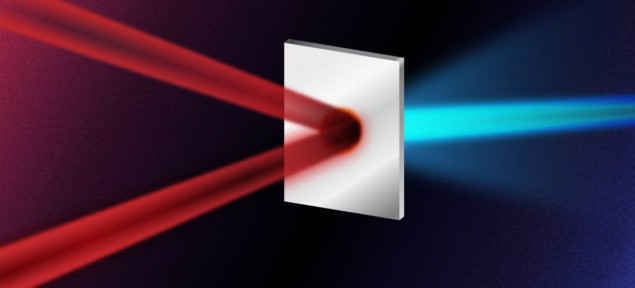
The energies of proton beams produced by laser-driven particle accelerators could be doubled, without any increase in laser intensity. That is the suggestion of computer simulations done by Tünde Fülöp at the Chalmers University of Technology in Sweden. The technique involves splitting the laser beam in two, and if realized in the lab, it could find a wide range of applications. These include the development of compact accelerators that could make cancer treatment more accessible.
While conventional accelerators use externally-applied electric and magnetic fields to accelerate charged particles such as protons, it can also be done by firing ultra-intense laser pulses at targets such as thin, metallic foils. The laser light deflects negatively-charged electrons in the target, while the much heavier positively-charged atomic nuclei are not affected. This charge separation generates a huge local electric field in the wake of the pulse that can be used to accelerate charged particles.
An important benefit of laser acceleration is that it can be achieved in using compact table-top equipment. This is unlike conventional accelerators, which must be house-sized or larger to achieve comparable particle energies. However, challenges remain in creating practical laser systems that deliver enough particles at the energies required for medical and other applications. Simply boosting the intensity of the laser pulse does not result in a corresponding boost in particle energy, for example.
Standing waves
Fülöp and colleagues argue that the energy problem could be overcome by splitting the laser pulse into two equal-energy pulses, which then hit the target simultaneously at different, precisely calculated angles of incidence (see figure). Through simulations, the team showed that when the laser pulses collide, a standing wave forms inside the solid target that increases the peak electric field. With the same pulse intensity used in previous experiments, their calculations suggest that the technique can double the energy of the proton beam and produce five times as many protons — all with far more flexible control parameters than required before.
The team’s discoveries could lead to compact accelerators for wide variety of technologies, including materials analysis, and testing spacecraft for their resilience against cosmic radiation. They could also lead to new and compact systems for targeted cancer therapies.
“We need to achieve up to 10 times the current [proton] energy levels to really target deeper into the body,” says Fülöp. “One of my ambitions is to help more people get access to proton therapy. Maybe that lies 30 years in the future, but every step forward is important.”
The research is described in Communications Physics.



